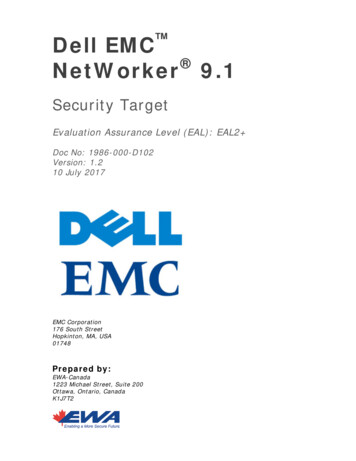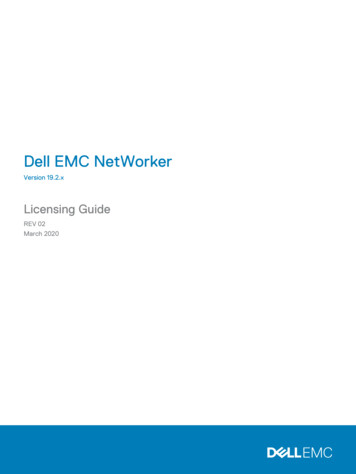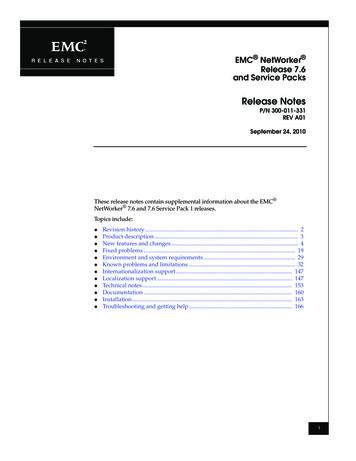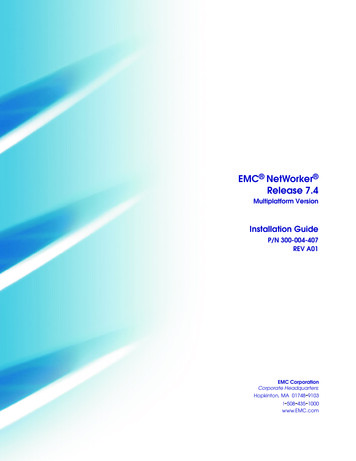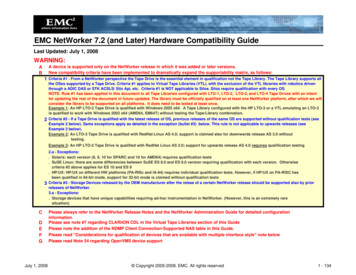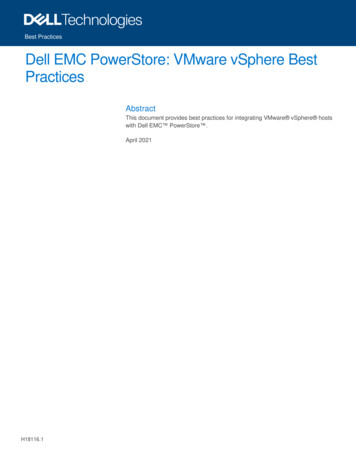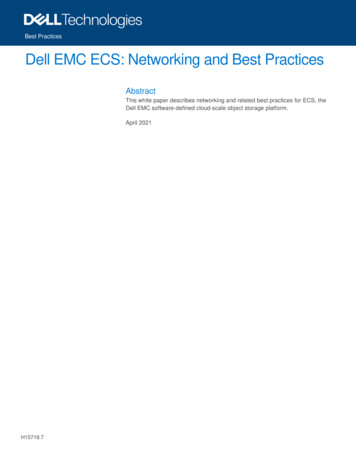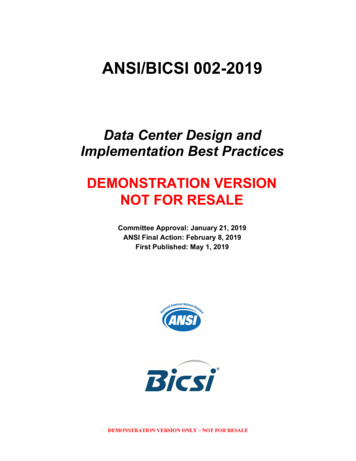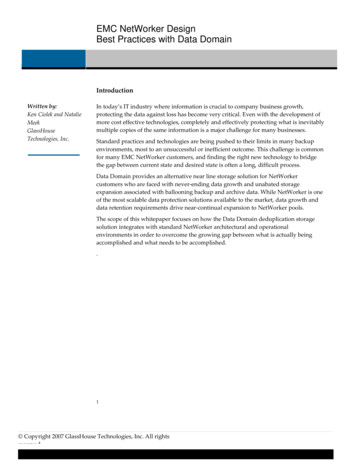
Transcription
EMC NetWorker DesignBest Practices with Data DomainGlassHouse WhitepaperIntroductionWritten by:Ken Ciolek and NatalieMeekGlassHouseTechnologies, Inc.In today’s IT industry where information is crucial to company business growth,protecting the data against loss has become very critical. Even with the development ofmore cost effective technologies, completely and effectively protecting what is inevitablymultiple copies of the same information is a major challenge for many businesses.Standard practices and technologies are being pushed to their limits in many backupenvironments, most to an unsuccessful or inefficient outcome. This challenge is commonfor many EMC NetWorker customers, and finding the right new technology to bridgethe gap between current state and desired state is often a long, difficult process.Data Domain provides an alternative near line storage solution for NetWorkercustomers who are faced with never‐ending data growth and unabated storageexpansion associated with ballooning backup and archive data. While NetWorker is oneof the most scalable data protection solutions available to the market, data growth anddata retention requirements drive near‐continual expansion to NetWorker pools.The scope of this whitepaper focuses on how the Data Domain deduplication storagesolution integrates with standard NetWorker architectural and operationalenvironments in order to overcome the growing gap between what is actually beingaccomplished and what needs to be accomplished.1 Copyright 2007 GlassHouse Technologies, Inc. All rightsreserved
The NetWorker Architecture and TerminologyThe EMC NetWorker client / server environment provides the ability to protect yourenterprise against the loss of valuable data. In a network environment, where theamount of data grows rapidly as servers are added to the network, the need to protectdata becomes crucial. The EMC NetWorker product gives you the power and flexibilityto meet such a challenge.Figure 1: Classic NetWorker Architecture Design2 Copyright 2007 GlassHouse Technologies, Inc. All rightsreserved
Each NetWorker server instance is supported by multiple self‐managed relational databases (resource,client file index and media) and various logs. Historically, customers backed up data directly to tape fornightly backups. Alternatively, more customers have moved to using file and advanced file type devicesto backup data to disk for faster write speeds. This data is then migrated daily to physical tape as areplica of the original data (commonly referred to as “clone” data) for purposes of disaster recovery andmedia recovery. Common terminology used in this whitepaper is provided in the following table.TermDefinitionClientA computer whose data can be backed up or recovered by aNetWorker Server.Storage NodeA Client with the ability (via SAN or SCSI connection) to backup data to a library or another storage location. Storage Nodescan also receive data from other NetWorker clients.SAN Storage NodeA NetWorker Client with the ability (via SAN or SCSIconnection) to back up its own data to a library or anotherstorage location (SAN Storage nodes can not back up otherclients).NetWorker ServerThe computer running the NetWorker server software thatcontains the NetWorker databases (client file index, media andresource) and provides backup and recovery operations to theclients on the same network. Servers can (and usually do)function as storage nodes.Data ZoneAll computers administered for backup and recovery by aNetWorker server. There can only be 1 NetWorker server in adata zone.Advanced File Type DeviceNetWorker term for disk backup locations with the ability toread and write simultaneously. The advanced file type(adv file) is usually created for large disk locations with theability to dynamically extended (using a volume manager) ifthe disk runs out of space while in use as an advanced file typedevice (usually during backup).Save SetA group of files or locations backed up onto a deviceGroupOne or more clients configured to back up data at a specifictime of the day.ScheduleThe level of backup (full, incremental, differential, skip) a clientis designated to run during a backupBrowse PolicyThe policy to determine how long data will reside in the ClientFile Index3
TermDefinitionRetention PolicyThe policy to determine how long data can be recovered.Client ResourceThe client resource lists the save sets to be backed up on aclient. It also includes the schedule, directive browse policy,and retention policy for the client. A client can have multipleclient resources however; the Savesets can not contain the sameinformation to be located within the same group.PoolsAn attribute in NetWorker that allows you to classify data.Pools are separated by the following information (inhierarchical order): Groups, clients, save sets, level.CloningThe act of copying backed up data. Clones function identicallyas the original backup volume. Cloning can be completedanywhere from one save sets to an entire volume (or multiplevolumes).StagingMoving data from one storage type to another. Staging alsolater removes the data from its original location.Full BackupA full backup is all files within a save set, regardless ofwhether they have been modified.Incremental BackupAn incremental backup only backs up any files that havechanged since the previous backup.Differential BackupDifferential backup is based on a numerical system.NetWorker has 9 levels of backup. Levels 1 through 9 backs upfiles that have changed since the last lower numbered backuplevel. Differential backups typically are configured to back upall data that has changed since the last full backup.Client File Index DatabaseThe database the tracks every file or object that is backed up.There is one Client File Index per physical client.Media DatabaseThe database that tracks the all save set and volume life cycleinformation. There is one Media database per data zoneResource DatabaseThe database that tracks all resource information (such asclients, schedules, groups, etc ). There is one resource database per data zoneTable 1: NetWorker Terminology4
Typical NetWorker ChallengesThe typical NetWorker environment supports a handful to thousands of clients. NetWorker scales byadding additional NetWorker storage node/SAN Storage nodes, and associated disk and tape resources.The most common challenges in NetWorker environments include: Completing backups, staging and cloning with limited time and physical resources Contending with extremely large client backups (several million files per client) Scaling NetWorker databases, logs, media management and pools to keep up with sheerdemand Eliminating redundant data backup locations (multiple full/incremental copies of databases,aggressive backup retention policies, etc.) Eliminating performance bottlenecks (NetWorker server type, networking, client issues, etc.) Lack of capacity planning and reporting disciplinesTechnology OverviewData Domain reduces unnecessary NetWorker data storage via inline data deduplication and traditionalcompression. Data deduplication is performed on incoming data streams and allows only the newsegments of data to be identified and stored as unique instances within the Data Domain file system. Thefollowing table lists key terminology for Data Domain.TermDefinitionData Domain SystemA standalone Data Domain storage appliance, gateway, or asingle controller in a DDX array.Protected Data SizeThe sum total of all file sizes in the set of primary data beingbacked up.Logical Storage SizeThe total size of all backup images in all pools on a DataDomain system. This total size includes all pools in NetWorkermapped to a Data Domain system instance, which can includeprimary disk pools, and clone storage pools.Disk Pool Dump SizeThe size of an individual backup image written to a pool (forexample, one night’s worth of “backup data”).Addressable CapacityThe amount of physical space available on a Data Domainsystem to store deduplicated and compressed backup images.Physically Consumed StorageThe amount of addressable capacity on a Data Domain systemcurrently storing backup data and associated metadata.Cumulative Compression FactorThe ratio of the logical storage size to the physically stored5
TermDefinitionspace.Periodic Compression FactorThe ratio of one or more disk pool dumps to the physicallyconsumed storage for those dumps. Note that the periodiccompression factor over any interval beyond the first few dayswill typically exceed the cumulative compression factor by alarge margin because the first version of a file written to a DataDomain system will compress less than subsequent versions.Consider for example two selective backups of 100 GB ofprotected data over two nights: typical periodic compressionfactors might be 2:1 the first night and 50:1 the second night,but the cumulative compression factor would only be 4:1 (200GB / 50 2 GB) rather than the 25:1 or so one might expect.Note further that while the cumulative compression factor iswhat determines cost per GB, it is the periodic compressionfactor that most affects replication bandwidth requirements.DeduplicationReplacing redundant 4KB to 16 KB segments in incoming datastreams with very small references to identical segmentsalready stored on disk. Also known as “global compression”.Local CompressionStandard lossless compression algorithms. The available LocalCompression algorithms available on a Data Domain systeminclude LZ (Lempel‐Ziv), gz and gzfast.CleaningA periodic process to find any unreferenced segments on aData Domain system and make that space available forsubsequent backups. Because Data Domain systems neveroverwrite data, file deletes by a NetWorker server do notimmediately make space available for subsequent backups —cleaning must run first. This cleaning process is not unique toData Domain systems. Cleaning may be performed on a DataDomain system at the same time as backup/restore I/O, butbecause cleaning is a fairly resource intensive process it is bestto schedule it for non‐peak hours. The default schedule forcleaning is Tuesday morning at 6:00 a.m. but may berescheduled for any convenient times during the week ormanually via script or command line.Table 2: Data Domain TerminologyNote: Data Domain’s patented approach to deduplication is called Global CompressionTM in DataDomain product literature, but for purposes of this whitepaper will be referred to as deduplication.Data Domain data deduplication methods are more granular and variable than fixed segment size datadeduplication competitors. Data Domain segment length is variable, ranging from 4‐16KB. This is a6
significant differentiator from competitive products which perform deduplication at the file level or at ablock level, resulting in more efficient deduplication capabilities.Since the rate of primary data change (newly introduced unique 4K to 16K segments) stays about thesame from night to night at most sites, the amount of physically consumed storage for a NetWorkerbackup is roughly the same as the physically consumed storage for an incremental NetWorker backup.The ratio of protected storage size to incrementally consumed physical storage each night stays about thesame, but the periodic compression factor of an incremental backup is much lower than the periodiccompression factor of a selective backup (because the former is much smaller in size). As a result, it isvery inexpensive to include many versions of files in a storage pool on a Data Domain system. Therelative size of protected data and incremental backup data, before and after de‐duplication andcompression is illustrated in the following figure.Figure 2: Backup Data Deduplication and CompressionBoth deduplication and standard data compression (also referred as ‘Local Compression’ in productliterature) are executed via loss‐less compression methods (i.e. no data integrity impact). Lempel‐Ziv (LZ)compression is standard, however GZFast or GZ are alternatives available to each Data Domain systeminstance for standard data compression. As always, backup data should not be compressed prior toattempting additional compression at the device level.7
Data Domain Architecture and ModelsA base Data Domain system supports a certain capacity of addressable storage (post‐RAID, post‐spares).Based on backup policy, this will enable 10x‐30x more logical capacity. For example, a system that offers10TB of addressable capacity would offer 100TB to 300TB of logical capacity. .Each Data Domain system instance supports 200MB/sec average throughput. This base metric appliesboth to read and write operations, as the architecture is optimized for sequential I/O.System NamePhysical CapacityLogical Data Storage (TB)Maximum I/OPerformance (GB/Hour)12,800(TB)DDX (with 16arrays)5048,800 – 20,000DDX (with 8arrays)2524,400 – 10,000DD58031.5550 – 1,250800DD56523.5400 – 980630DD5304.555 – 140360DD5102.2525 – 65290DD1200.757‐181506,400Table 3: 2007 Data Domain Systems, Addressable and Logical CapacityNote: Logical Data Storage Values above reflect deduplication and compression effects on backup data.The actual values are highly dependent on rate of change and backup policies.The solution scales modularly by incrementally adding either capacity to an existing Data Domain systeminstance in the case of the DD580 or the DDX, or adding a new Data Domain system instance to theNetWorker production environment. Multiple Data Domain system instances can be racked andmanaged through an enterprise console; however logical management of each Data Domain systeminstance is still required. The following figure illustrates Data Domain system architecture scalability.8
Figure 3: Data Domain System Architecture ScalabilityFile System and VTL IntegrationData Domain systems support two integration methods with NetWorker, either via network file systemmounts or as a standalone Virtual Tape Library (VTL). Data Domain systems can run in a mixed modecapacity, providing both interface methods concurrently to one or many NetWorker server instances.This flexibility affords a great number of integration scenarios for NetWorker. The following figureillustrates both integration scenarios with NetWorker Servers and Storage Nodes.9
Figure 4: NetWorker ‐ Data Domain System IntegrationFor network file system access, NetWorker addresses the Data Domain system via a native NFS mount orCIFS. NetWorker addresses the usable space exactly as it would a standard file system mount point(NTFS, JFS, UFS, etc.).The VTL interface emulates a STK L180 tape library, and requires a fiber‐channel connection along withthe appropriate NetWorker device driver. NDMP backups are supported with a DDR attached directly tothe NAS host via a fibre channel connection. Multiple instances of VTL can be created per Data Domainsystem instance. Up to 64 LTO tape drives, 10,000 slots, and 100,000 virtual cartridges can be created perData Domain system instance. As a standalone VTL, existing physical tape resources can be leveraged bynative NetWorker capabilities.ReplicationAsynchronous data replication is supported between Data Domain system instances. Once the initialmirror replica is established, only changes to index/metadata and new data segments are replicated to the10
target site. As a result, WAN bandwidth requirements are reduced by up to 99% and the amount of timeto replicate data to an offsite location is reduced significantlyReplication is configured in Collection or Directory mode. Collection mode allows single Data Domainsystem instances, both NFS and VTL, to be configured in a source‐target relationship, with one‐wayreplication only. Directory replication supports many‐to‐one configurations which are established at thedirectory/mount level. Directory replication supports bidirectional replication between Data Domainsystem instances, which is ideal for various DR architectures, including hub‐spoke architectures forremote offices. VTL instances emulate NFS Directory replication at the VTL pool level where options areset to indicate the source is a VTL pool.Figure 5: Collection and Directory Replication ModesHow Data Domain Best Fits with NetWorkerA Data Domain system provides an alternative for disk and tape volume pools in NetWorker. The DataDomain file system is optimized for sequential read and write operations. This provides for a great fitwith existing NetWorker disk‐based or VTL abilities. A Data Domain system is best configured as anadvanced file type in NetWorker.11
NetWorker databases should continue to be provisioned on traditional disk devices. A Data Domainsystem should not be used for storing active NetWorker databases, logs, and configuration files. Instead,these NetWorker elements can be backed up to a Data Domain system for operational recovery andreplicated to a remote site for disaster recovery.Note: Some NetWorker environments support extremely high‐performance backups for high‐volumeclients. Typically, specialized designs are implemented to support backups of 1‐4 TB/hour. The DataDomain system architecture can be configured to support high‐performance workloads (via multiplesave streams) with each Data Domain system instance supporting 200 MB/sec aggregate workloads percontroller on currently shipping Data Domain systems. Because Data Domain’s product architecture isCPU‐centric, this number typically changes (upward) with new product releases in a given price band.The top end of the Data Domain controller line, with dual‐socket Intel CPU components, has gone from40 MB/sec. (DD200 in year 2004) to more than 200 MB/sec (DD580/g in year 2007), a factor of five increaseover three years. Please check current Data Domain literature for current platform names andthroughput.Planning / Sizing ConsiderationsBackup Policies and Data Rate of ChangeNetWorker policies are unique to each customer environment, but typically follow a commonmethodology. Most sites use a mixture of incremental backups with full backups run on a regularschedule (weekly or monthly). Incremental backups are more typical because they are faster and take upless space on the backup device. This leaves the full backups taking up more disk and tape space. Everyfull backup will write redundant data that exists in previous full backups, resulting in a large amount ofthe budget being lost to consumed disk capacity, more and unnecessary tape storage, offsite charges, anddrive resource contention.The impact of this redundant full backup data becomes much less significant when deduplication isintroduced. Data Domain systems facilitate Synthetic Full backups, the goal of which is to create a fullbackup image from existing backup data. This process allows the NetWorker backup environment tobenefit from an ‘incremental forever’ methodology without officially adopting such a scheme. In the end,though, the change rate of the data is the final arbiter for the amount of backup data stored.From a NetWorker perspective, a database backup may appear ‘net new’ each time it is backed up, butfrom a Data Domain system perspective, the actual data changes may result in minimal new physicalstorage consumption. Databases, email, and unstructured data (file server data) will benefit the mostfrom data deduplication in most production environments. Data growth issues are compounded by non‐working copies of data used for reporting or testing, all of which are typically backed up daily byNetWorker. The net result is a never ending demand for physical storage resources. Data Domaincounters the effects of uncontrolled backup data growth.Deduplication benefits are realized over time and eventually plateau once the backup versioning policyand the incremental backup traffic is fully realized. Since data change rates vary by data type andproduction environment, a combination of backup policies, data change rate, and data structure impactsData Domain system sizing estimates.12
SizingSizing storage capacities f
for many EMC NetWorker customers, and finding the right new technology to bridge the gap between current state and desired state is often a long, difficult process. . NetWorker has 9 levels of

